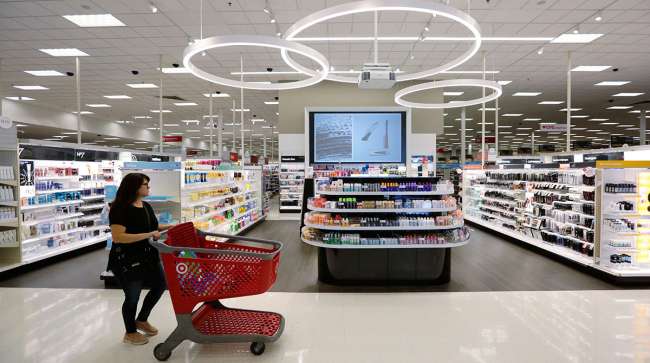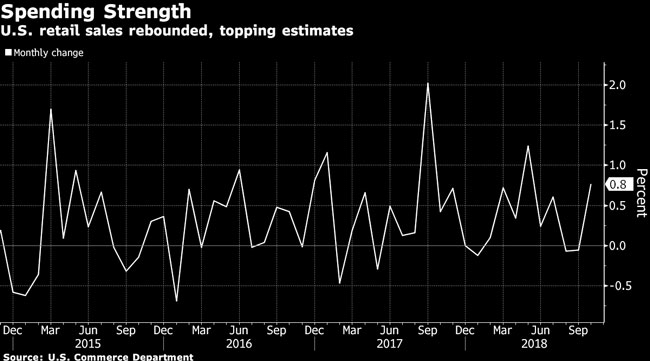Retail Sales Rise Most in Five Months on Autos, Fuel

U.S. retail sales rose in October by the most in five months on purchases of autos, fuel and building materials, rebounding after Hurricane Florence may have depressed demand in September.
The value of overall sales increased 0.8% after a 0.1% decrease in the prior month that was revised from a gain, Commerce Department figures showed Nov. 15. The median forecast of economists surveyed by Bloomberg called for a 0.5% advance.
The results indicate that consumption, which represents about 70% of the economy, continues to advance in the final three months of the year after posting the best back-to-back quarters of growth since 2014.
Yet some of the details of the report concerned economists: In the “control group” subset, which can help gauge underlying consumer demand, sales climbed a below-forecast 0.3%after a downwardly revised 0.3% increase in September. The measure excludes restaurants, car dealers, building-materials stores and gasoline stations.

The slowdown in this measure from earlier in the year “looks very much like the end of the boost from the tax cuts, and it strengthens our conviction that GDP growth has peaked,” Pantheon Macroeconomics Chief Economist Ian Shepherdson said in a note.
The data may be distorted by the effects of storms including Florence, which made landfall Sept. 14 in North Carolina, and Michael, which struck Florida on Oct. 10. In addition to the effect of tax cuts possibly wearing off, other headwinds include higher borrowing costs and companies potentially passing on the costs of tariffs in a trade war with China.
Even so, the data probably reinforce investor bets that the Federal Reserve will lift interest rates in December for the fourth time this year and stay on a tightening path in 2019.
A separate report Nov. 15 from the Labor Department showed filings for unemployment benefits remained low last week, continuing to signal a tight job market. Initial jobless claims rose by 2,000 to 216,000, not far from the lowest level since 1969.
Other survey data gave a mixed picture of manufacturing in the northeastern U.S.: The Federal Reserve Bank of New York’s Empire State factory index rose to a three-month high of 23.3, while a similar index for the Philadelphia Fed region declined to a three-month low of 12.9. The Philadelphia gauge of expected business conditions in six months fell to the lowest since February 2016.
Spending Growth
Economists surveyed by Bloomberg expect consumer spending to grow at a 2.8% annualized rate in the fourth quarter, following 4% in the previous three months.
Retail Analyst Mickey Chadha comments on US #retail sales data for October:
"Strong economic fundamentals, inventory management, store optimization, and integration of brick-and-mortar & e-commerce platforms have all contributed to improvement in the topline growth for retail." pic.twitter.com/AeUgRYF6l5 — Moody's Investors Service (@MoodysInvSvc) November 15, 2018
Ten of 13 major retail categories showed increases in October, according to the Commerce Department data. Sales at automobile and parts dealers rose 1.1%, the most since March, after decreasing 0.1% in the previous month.
Filling-station receipts increased 3.5%, the report showed. The Commerce Department figures aren’t adjusted for price changes. Labor Department data Nov. 14 showed seasonally adjusted gasoline prices rose 3% in October from the prior month.
Excluding cars and gasoline, retail sales rose 0.3%, after no change the previous month.
Sales at building-material stores rose 1%, the most since May. Other categories with gains included electronics and appliance stores, rising 0.7%, while three categories recorded 0.5% increases: clothing; sporting goods, hobby, musical instruments and books; and general merchandise.
Receipts at furniture and home furnishings stores fell 0.3%, while restaurants and bars were down 0.2%, the second straight drop. Sales at health and personal care stores were little changed after a 0.1% decline.
Shopping and consumer activities such as eating out at restaurants would have been most affected in North Carolina and South Carolina in the aftermath of Florence. At the same time, such negative fallout tends to be temporary.




